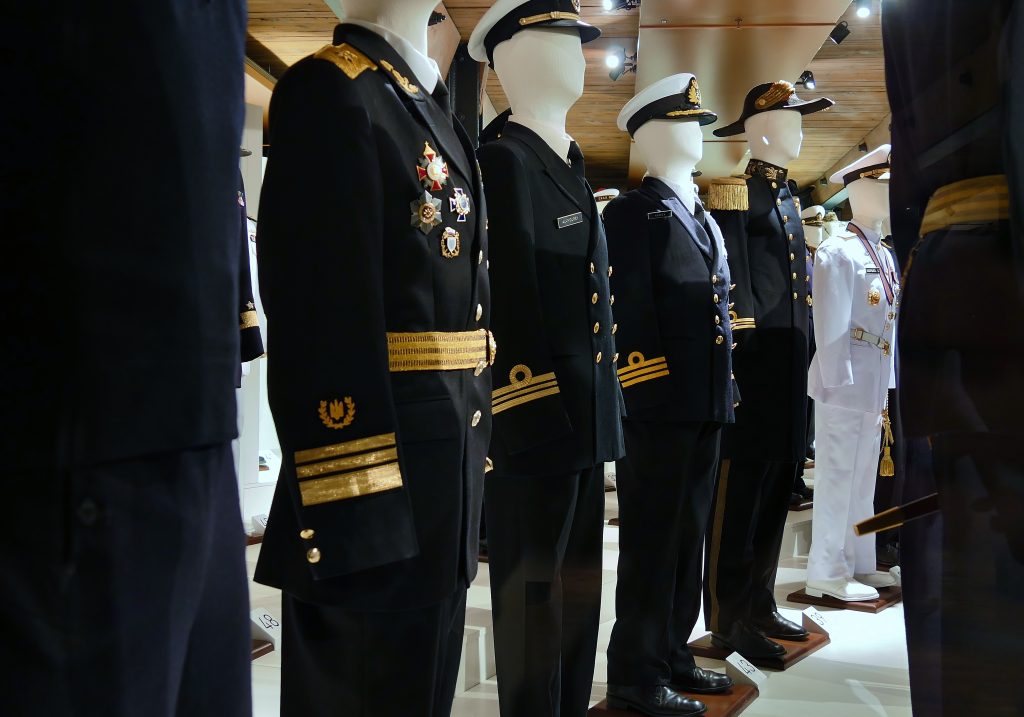Guide to deck 4: Serving on Board

40 – Introductuion: Deck 4, Serving on board
Audioguide:
Right from the entrance area of Deck 4, the visitor’s eye is drawn to the formal language and purposes of orders and decorations. Medals do not only serve military leaders as an expression of their position of power. As visible recognition, they also motivate ordinary soldiers. An award raises the honoured person above other members of his or her community.
In the 19th century in particular, orders and decorations had a high social status. State awards allow conclusions to be drawn about the history of the country and its relationship to other countries.
The tour of the exhibition begins behind the stairs. If you turn left there, your gaze will fall on a large display case. In it, almost 60 figures dressed in historical uniforms from all over the world stand peacefully together. A little further on, you see almost 100 headdresses from different countries and eras. There is a good reason why Deck 4 sees itself as the „armoury of history“.
Separate areas are dedicated to pastoral care and the medical service. You can also learn interesting facts about festivities and customs on board.
An important expression of rank and dignity is bare and firearms. Whether as tools or weapons in action – the development of this indispensable part of an outfit can be studied on this exhibition deck.
41 – Uniforms
Audioguide:
The uniform is the standardised clothing of a professional group. They can be found, among others, in the military, police and customs. Wearing a uniform enables a representative, visually uniform appearance in public. A uniform documents both the rank and the field of expertise of the wearer.
The clothing of seafarers has always been fit for purpose. The requirements of daily service in particular determine the material and cut.
Blue and white uniforms from a total of 26 nations dominate this display case. This is by no means coincidental. In 1758, the British navy was equipped with blue uniforms by King George II. The buttons on the suits were gold. The dress style of the British marines is still the model for international uniform development today.
In the tropics, marines wear white uniforms. Buttons, rank insignia and braid are also mostly gold in these suits. Golden buttons proved to be relatively resistant to salty seawater.
Naval uniforms are often wide-cut and have an open neckline. A generous neck and chest area does not restrict the wearer’s freedom of movement. This was especially important on sailing ships.
The sailors‘ collars were originally worn loosely to protect the jacket from dirt.
There was no prescribed uniform for crews and officers until the middle of the 18th century. Until then, they dressed in the style of the civilian population. In 1795, English officers wore epaulettes as a badge of rank for the first time.
42 – Women in Naval Service
Audioguide:
A career in the navy is also open to women today. Female soldiers are largely subject to the same conditions as their male colleagues. This was not always the case.
During the First World War, women served mainly in the medical, clerical and radio services. In the Second World War, tasks in flight reporting and intelligence were added.
As early as 1950, women occupied various positions in the People’s Navy of the GDR. In the Federal Republic of Germany, military service was initially closed to women. In 1976, the German Navy awarded a medical officer position to a female applicant for the first time. Since 2001, all naval careers in Germany have been open to women.
The situation was similar internationally. For the most part, leadership positions for women did not exist in foreign navies until after the Cold War.
43 – Naval Hats
Audioguide:
As late as the 17th century, the headgear of naval personnel was still oriented towards the style of the time. Only then did caps, hats and helmets become standardised components of an outfit. In addition to their use as head protection, soldierly headgear served as an external symbol of rank and national affiliation.
From the middle of the 18th century onwards, ranks often wore round hats made of felt or leather. To protect them from the weather, the hats were given a covering coat of tar.
During the cold season, marines dressed in fur-lined leather caps. In summer, straw hats were worn. Around the headgear, the sailors tied a blue ribbon with the name of their ship. Today’s cap band has its origins in these earlier trimmings.
The round hats of the crews developed into the two-pointed hats of the officers, which were worn with the tips pointing forwards and backwards.
From about 1800 onwards, the slightly cylindrical chako became the accepted headgear of the marines. It somewhat resembles the top hats of the time.
44 – Spirituality and Healthcare aboard
Audioguide:
Life on board is not always easy. Especially on long voyages, personal problems can grow into threatening crises. As escorts on a naval ship, military chaplains take on important functions.
Naval chaplains stand by the soldiers in their distress. In addition to confidential talks, military chaplains are also responsible for conducting church services.
Since the end of the 19th century, chaplains served as site priests at naval stations. The prescribed church service took place regularly on all Sundays and holidays. To this day, a church pennant is placed above the flag during a shipboard service.
Military chaplaincy was maintained even during the National Socialist era. The most important advocate proved to be the Commander-in-Chief of the Reich and Kriegsmarine, Erich Raeder.
An important task within the navy was assumed by the medical service. The requirements that a naval doctor must fulfil go far beyond the possession of a state licence to practise medicine. In many countries there are special educational institutions for naval physicians. They teach naval surgery, tropical medicine and ship and tropical hygiene.
At the time of the large sailing ships, there were often considerable health risks on board due to poor hygiene. In the 19th century, English and French naval physicians set standards in the introduction of hygienic standards.
Medical personnel as well as military chaplains are protected by the Geneva Convention.
45 – Weapons
Audioguide:
The indispensable part of a ship’s equipment includes blank and firearms.
The collection presented here documents the development of the hand weapon. The exhibits reflect a cultural history of a good 3000 years. The exhibition has a study character: it ranges from primitive hand axes to magnificent ornamental weapons.
Blank weapons are all cutting, stabbing, striking and hand-throwing weapons. Typical representatives of the genre are epees, sabres or swords. Nowadays, edged weapons are mostly used for ornamentation. They are also still used in international navies as an external sign of recognition of the officer’s rank.
Bare weapons often have a symbolic character. As a sign of surrender, a captured officer handed over his rapier to the victorious commander. A knighthood is awarded with the sword.
The blades, which are not infrequently decorated with gold, are sometimes decorated with maritime ornaments, monograms or mottoes. Handles and scabbard fittings were usually made of brass. The robust metal proved to be relatively resistant to weathering and salt water.
From the 19th century onwards, naval officers regularly carried a sabre. Daggers were also popular. A so-called portepee was attached to the bare weapons of the leading personnel. It is the insignia of rank for officers.
Between the end of the 14th and the middle of the 19th century, international navies used so-called muzzle-loading rifles as firearms. Powder and bullet were fed into the muzzle of these weapons. The ignition was done from the outside. Reliable firing mechanisms first appeared on the market around 1830. Metal cartridges were used from 1875 onwards.
46 – Life on board
Audioguide:
In the late 19th century, compulsory military service began when conscripts reached the age of 17. Active service lasted three years. This was followed by the period of reserve service.
Infantry training began immediately after induction. This was followed by instruction in boat duty, gunnery drill and other shipboard duties. Particularly suitable soldiers also received special training. Regular driving exercises were held to reinforce what had been learned.
The First Officer was responsible for determining the duty rosters. The division service included all military tasks. The distribution of work summarised all economic activities.
On the ships of all international navies, the training courses were similar. In principle, they have survived to the present day.
Leisure activities on a ship follow their own rules. In radio- and TV-less times, the ship’s band played a central role. Many sailors mastered a musical instrument. The accordion was particularly popular.
On today’s warships, superiors pay attention to meaningful leisure activities. Joint games and sports events are regularly on the programme. Film screenings, shipboard parties and shore excursions also contribute to recreation.
Food and drink are important for well-being on board. Today, the soldiers‘ meals are considered sufficient, balanced and rich in vitamins. In earlier times, superiors took their meals in the officers‘ mess. The crews ate separately at the „Back“. The term stands for the tables in the battery or tween decks. The tableware of the crews consisted of a dinner bowl and a simple drinking vessel. Officers, on the other hand, used silver cutlery and valuable dining sets.

